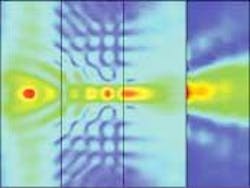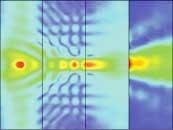Indefinite medium focuses light
The development of optical materials with a negative refractive index would allow the creation of (non-gradient-index) refractive focusing lenses that have flat surfaces, as well as other optical elements and systems that would appear quite odd to traditional optical designers. Attempts to model and fabricate such materials have centered on the creation of metamaterials, or materials that have a periodic substructure and are often made of intricate configurations of differing shapes that serve as wavelength-scale resonators (see Laser Focus World, July 2003, p. 11). Concentrating on microwave frequencies has allowed the fabrication of metamaterials at millimeter scales reasonable for experimentation, rather than the submicron scales necessary for use at optical wavelengths.
The difficulty of creating metamaterials that have negative refraction has spurred researchers at the University of California–San Diego (UCSD), to examine an easier approach.1 While a material with negative refractive index can be created by making its permittivity and permeability negative, this is difficult. A simpler solution is to let the material be anisotropic, and to let permittivity and permeability values have different signs (they are actually tensors, so in reality, individual tensor elements are allowed to have different signs—an even looser constraint). Such materials, termed indefinite media by the researchers, cannot yield a pair of aplanatic points (ideal for imaging) when made into a slab, but they can potentially focus light.
"The two reasons that we have studied indefinite media are that they have interesting dispersion characteristics, including supporting negative refraction, and that they ease fabrication requirements." says David Smith. "So far, it has proven very challenging to form a metamaterial medium that has isotropic properties in three dimensions. Part of the reason is that the elements—split rings, wires, and so on—have a somewhat complicated electromagnetic response in general. When we restrict our attention to certain polarizations or directions of wave propagation, they behave reasonably; however, it is difficult to design metamaterials based on these elements that have controlled response for all polarizations and direction of propagation. Indefinite media, in which we allow some restrictions in the possible ways that incident waves will propagate, are much easier to design. Moreover, it is much easier to fabricate and assemble a metamaterial if elements are not required in all three dimensions."
The researchers fabricated a metamaterial containing split-cell ring resonators with a unit cell size of 3.33 mm in the vertical direction and 5 mm in the propagation directions. Experiments were carried out at microwave frequencies from 9 to 14 GHz in a 2-D scattering chamber made of two 3 × 3-ft aluminum plates separated by 1 cm. Simulations show that the metamaterial, which has a permittivity of –1 near 11.3 GHz, should partially focus light from a source; experimental measurements confirm this, showing substantial field enhancements (see figure).
Although indefinite media cannot form aplanatic points when made into a slab, contouring the front and back surfaces should allow aplanatism. The UCSD researchers are collaborating with Boeing (Chicago, IL) to develop lenses based on indefinite media.
REFERENCE
- D. R. Smith et al., Appl. Phys. Lett. 84(13) (March 29, 2004).

